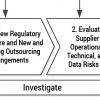Business Transformation Requires Transformational Leaders
Leadership and teaming skills are front and center in times of rapid change. Meet today’s constant disruption head on with expert guidance in leadership, business strategy, transformation, and innovation. Whether the disruption du jour is a digitally-driven upending of traditional business models, the pandemic-driven end to business as usual, or the change-driven challenge of staffing that meets your transformation plans — you’ll be prepared with cutting edge techniques and expert knowledge that enable strategic leadership.
Subscribe to Arthur D. Little's Culture & Leadership Newsletter
Insight
Broadly, there are two facets to the people architecture. One facet is the desire to imagine; to make things better, to exploit new ways and technologies, to renew and replace the old. The other is grounded in the reality of the things, the people, and the ways of doing that took years to get to where they are today, with all their intricacies and nuances: the rust. But it is in the space between the imagination and the rust that things either turn to dust or get forged into what they must.
There are a lot of use cases for blockchain technology, and the business case for each needs to be developed. A lot of companies exist with a blockchain solution for a problem that does not exist — essentially a hammer searching for a nail. The use cases outlined in this Advisor have common benefits focused on simplifying existing relationships, reducing fraud, and improving the speed of commerce.
Leaders peering over the edge of the horizon of their own and adjacent industries might wonder, “What are companies that have achieved digital success doing differently?” We believe that at the heart of the ability to manage an ongoing and multilayered organizational transformation rests a sophisticated enterprise architecture capability with a specific charter to act as a transformation engine connecting strategic intent and execution excellence.
The success of Global Business Services (GBS) in managing this transition and in meeting the evolving expectations of business divisions has contributed to a sea change in Dell EMC in which all departments are being asked to align for business-driven digital transformation. This has prompted discussion around the changing value proposition of GBS over time, which began as a set of orthogonal and functional agreements but has transitioned into a process-entangled, bottom-up engine of collaboration, innovation, and personal development.
Governing the Cloud: Managing Sustainable Compliance
In this Executive Update, the last of three related Updates, we evaluate how financial organizations are responding to the new challenges of cloud outsourcing and continue to distill our findings based on research and data collection conducted from 2014-2016. Using insight from our interviewees, we share some action points through a framework that enables organizations to manage this increasingly complex, crucial area. We also outline some good practices for managing cloud-based innovation on a continuing basis in order to maintain daily compliance.
Regardless of whether Agile teams operate with or without a scaled framework, the need to match the expectations of the business users on the receiving end of the value generated by the team with the internal measures of throughput is critical. The three challenges described in this Advisor highlight the importance of measuring value in the eyes of the recipient of the output of work, not only the effort generated to attain value.
At the Cutter Digital Transformation & Innovation Bootcamp, Cutter Fellow and Harvard Business School Professor Karim Lakhani talked about digitally-driven disruption of traditional business models for value creation and capture, discussing platform models like Facebook and Twitter. To date, Twitter has clearly done a good job “creating value.” But unlike Facebook, it continues to struggle with the capture part of the equation.
In this on-demand webinar, Cutter Senior Consultant Paul Harmon considers the growing role of artificial intelligence and cognitive technologies in all aspects of business. He argues that cognitive technologies will simply extend the ongoing digital transformation requiring that companies reconsider their business models and processes yet again and that they will need to incorporate intelligent elements to remain competitive.

















